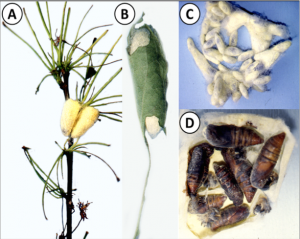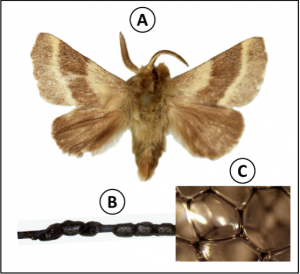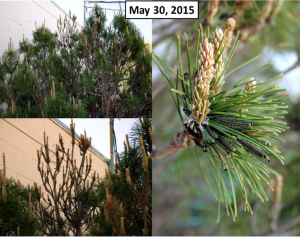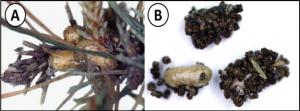—Dr. Robert Bauernfeind
Yes —- there is a connection (although admittedly I may streeeetch the rubber band thin). The Kentucky Derby is held the first Saturday of May (tomorrow – May 2) and the winning horse will cross the finish line making some bettors and owners HAPPY!!! Coinciding with this Annual Run-for the-Roses are Eastern tent caterpillars and European pine sawflies which also are fast approaching the finish line for their yearly foraging activities.
ETCs are nearly mature. I expect that by next week, they will have begun transitioning into their pupal stage. This begins with caterpillars creating their silken cocoons which are coated with a whitish/yellowish powdery substance (which can be irritating to a person’s skin and eyes).
Caterpillars may remain on the host plant, their cocoons being exposed (A) or somewhat concealed/wrapped in a leaf (B). Sometimes caterpillars may go “walkabout”, leaving their tree host to make an individual cocoon, or sometimes gathering and making cocoon clusters (C). After formation of cocoons has been completed, caterpillars transition into their pupal stage (D).
By late May/early June, moths (A) will emerge and mate. Egg masses will then be deposited on twigs (B). A hard shellac-like coating (C) protects the eggs through the summer heat and rigors of winter. Their cycle will be renewed with egg hatch and caterpillar emergence in March of 2016.
Regarding EPS, one has but to approach a heavily infested pine to know that the larvae are nearing the end of their feeding stage. The sparse/bare branches (a result of increasingly large larvae satisfying their ravenous appetites) signal an approaching end to their feeding cycle.
Within a week, larvae will begin forming their thin-walled papery and somewhat leathery cocoons. Like eastern tent caterpillars, some larvae will form cocoons while remaining on their host (A). However, most will leave their host to form cocoons elsewhere. Cocoons may not be obvious because they will be camouflaged with particles of dirt and debris. When cocoons are formed under their host tree, the dirt/debris consists mostly of fecal pellets (B) which dropped to the ground by larvae as they fed.
Unlike the rather immediate appearance of adults/mating/egg production of eastern tent caterpillars, European pine sawfly larvae aestivate (period of “rest”/decreased metabolic activity in response to higher temperatures) during the summer months. Actual pupation occurs in the fall followed by the emergence of adult sawflies (A) at which time mating occurs and overwintering eggs are inserted into needles (B). Their cycle will be renewed with egg hatch and larval emergence in late March/early April of 2016.





